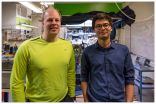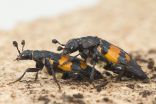(Press-News.org) March 9, 2015 -- Unhealthy weight gain in pregnancy has been linked with infant size and body composition but until now little was known about its long-term association with childhood obesity among low-income and multi-ethnic youth. For the first time, researchers at Columbia University's Mailman School of Public Health studied the effects of gestational weight gain on childhood obesity risk among a multi-ethnic urban population. The researchers determined that excessive pregnancy weight gain was associated with greater overall and abdominal body fat in children and obesity at age seven. Excessive pre-pregnancy weight gain was associated with an increased risk of childhood obesity of approximately 300 percent. Findings are published online in the journal Maternal & Child Nutrition.
Before pregnancy for this population of African-American and Dominican women, 45 percent were overweight or obese, and 64 percent of mothers gained more weight during pregnancy than recommended by the 2009 Institute of Medicine Guidelines. At age seven, 22 percent of the children born to the women studied were obese, and on average, 24 percent of their body mass was comprised of fat tissue. The 2009 Institute of Medicine Guidelines for weight gain during pregnancy were set to optimize prenatal, birth, and possibly longer-term health outcomes, and recommended that pregnant women gain weight within set ranges according to their pre-pregnancy body mass index. For example, it recommends that women in a normal weight range gain 25-35 lbs and approximately 1 lb per week in the 2nd and 3rd trimester. These guidelines should be used in conjunction with clinical judgment by healthcare providers.
"This is the first study to evaluate the long-term effects of gestational weight gain in a contemporary low-income multi-ethnic urban population, characterized by a high risk of obesity," noted Elizabeth Widen, PhD, RD, postdoctoral fellow at the Mailman School Department of Epidemiology, the Institute of Human Nutrition, and the New York Obesity Research Center.
Findings were based on data from the Columbia Center for Children's Environmental Health Mothers and Newborns Study in Northern Manhattan and the South Bronx from 1998 to 2013. There were 727 mothers who self-identified as African-American or Dominican.
Most studies examining longer term effects of pregnancy weight gain on childhood body size typically only have measures of height and weight rather than estimates of body fat. Further, there has been little research on the long-term effects of gestational weight gain on childhood obesity risk in vulnerable populations.
"Our findings suggest that weight gain in pregnancy above the Institute's recommendations is strongly associated with obesity in childhood," said Andrew Rundle, DrPH, associate professor of Epidemiology. "A stronger focus on helping pregnant women meet the Institute of Medicine's targets for healthy weight gain during pregnancy is needed."
The researchers controlled for pre-pregnancy body mass index, maternal education, receipt of public assistance, ability to afford food in pregnancy, and previous pregnancies. Women were also excluded from the analysis if the first prenatal visit was after 20 weeks gestation or if the mother self-reported diabetes, hypertension, known human immunodeficiency virus status, or use of illicit drugs or cigarettes during pregnancy. Marital status and infant sex had no effect on outcomes.
"Some weight gain during pregnancy is normal, but women need to know that gaining too much weight can put their child at risk for being obese in childhood and as they get older, which places them at higher risk for future chronic disease. Because pregnancy weight gain has lasting implications for childhood health, we need to determine how to support women to gain a healthy amount of weight in pregnancy," said Widen.
INFORMATION:
The study was supported by the National Institute of Environmental Health Sciences (NIEHS) and the U.S. Environmental Protection Agency (EPA) Children's Environmental Health and Disease Prevention Research Centers (NIEHS/EPA P01ES09600/R82702701, NIEHS/EPA P01ES09600/RD832141, NIEHS/EPA P01ES09600/RD834509). The Irving General Clinical Research Center (RR00645), the National Institute of Diabetes and Digestive and Kidney Diseases (NIDDK T32DK091227), the Educational Foundation of America, the John and Wendy Neu Family Foundation, the New York Community Trust and the Trustees of the Blanchette Hooker Rockefeller Fund also supported the study.
A symposium titled "A Smart Start: Preventing Childhood Obesity," sponsored by the Mailman School of Public Health's Obesity Prevention Initiative will take place on April 16th. Journalists are invited to attend.
About Columbia University's Mailman School of Public Health
Founded in 1922, Columbia University's Mailman School of Public Health pursues an agenda of research, education, and service to address the critical and complex public health issues affecting New Yorkers, the nation and the world. The Mailman School is the third largest recipient of NIH grants among schools of public health. Its over 450 multi-disciplinary faculty members work in more than 100 countries around the world, addressing such issues as preventing infectious and chronic diseases, environmental health, maternal and child health, health policy, climate change & health, and public health preparedness. It is a leader in public health education with over 1,300 graduate students from more than 40 nations pursuing a variety of master's and doctoral degree programs. The Mailman School is also home to numerous world-renowned research centers including ICAP (formerly the International Center for AIDS Care and Treatment Programs) and the Center for Infection and Immunity. For more information, please visit http://www.mailman.columbia.edu
EUGENE, Ore. -- March 9, 2015 -- University of Oregon geologist Qusheng Jin initially labeled his theory "A Wild Hypothesis." Now his study of arsenic cycling in a southern Willamette Valley aquifer is splashing with potential significance for arsenic-compromised aquifers around the world.
In a paper online ahead of regular publication in the journal Nature Geoscience, Jin's five-member team reports on a bacterial process that turns toxic inorganic arsenic into organic forms that usually are considered to be less dangerous. Jin's conclusion now is that organic arsenic ...
SAN FRANCISCO (March 9, 2015) -- A team of Brazilian scientists--including Luiz Rocha, PhD, Associate Curator of Ichthyology at the California Academy of Sciences--is raising awareness about impending conservation setbacks for Brazil's aquatic animals, calling for immediate fisheries management collaboration between the nation's public and private sectors. The scientists say Brazil can transform this moment of political turmoil into positive action--and become a leader among developing countries facing widespread extinction of aquatic fauna. The call to protect the future ...
Vildagliptin (trade name Galvus or Jalra) has been approved since September 2007 for adults with type 2 diabetes mellitus in whom diet and exercise do not provide adequate glycaemic control. The German Institute for Quality and Efficiency in Health Care (IQWiG) examined in a new dossier assessment whether this drug offers an added benefit over the appropriate comparator therapy. Such an added benefit cannot be derived from the new dossier either, however, because the drug manufacturer did not submit any suitable data.
Manufacturer itself applied for a new dossier assessment
Neither ...
Atomic clocks are the most accurate clocks in the world. In an atomic clock, electrons jumping from one orbit to another decides the clock's frequency. To get the electrons to jump, researchers shine light on the atoms using stabilised laser light. However, the laser light has to have a very precise frequency to trigger very precise electron jumps. It is however challenging to get the laser light frequency ultra precise - there will always be a little 'noise'. Now researchers from the Niels Bohr Institute have developed a method that reduces the noise so that it is up to ...
The drug combination of ledipasvir and sofosbuvir (trade name Harvoni) has been available since November 2014 for the treatment of chronic hepatitis C infection. The German Institute for Quality and Efficiency in Health Care (IQWiG) examined in a dossier assessment whether this new drug offers an added benefit over the appropriate comparator therapy.
IQWiG found a hint a non-quantifiable added benefit for two out of seven patient groups in total: in an infection with genotype 1 hepatitis C virus (HCV) when previous therapies had been unsuccessful, and when previously ...
HEIDELBERG, 10 March 2015 - An international group of researchers has shown that a regulatory protein involved in controlling how cancer spreads through the body also influences the fate of stem cells in the intestine of mice. The results, which are published in The EMBO Journal, show that the Snai1 protein plays an important role in deciding the fate of intestinal stem cells and the different functions that these cells can adopt.
"Our results show that Snai1 is a key regulator of crypt base columnar cells, a type of stem cell found in the invaginations or crypts that ...
New research conducted by The University of Manchester has found that GPs' patients can feel alienated by lack of trust, impersonal processes and that this presents problems to improving their safety.
Most research into patient safety focuses on the systems operated by health services. This is particularly focused on hospitals. However, most encounters occur within GP services where relationships between doctor and patient can form a significant part of reaching successful diagnosis and treatment.
The team from the NIHR Greater Manchester Primary Care Patient Safety ...
Study suggests that millions of modern Asian men are descended from 11 ancient leaders, including Genghis Khan
Sample examined the Y chromosomes of 5,000 Asian men from 127 populations
Historical nomadic and mobile populations allowed for Y chromosomes to be spread far and wide
Geneticists from the University of Leicester have discovered that millions of modern Asian men are descended from 11 powerful dynastic leaders who lived up to 4,000 years ago - including Mongolian warlord Genghis Khan.
The study, which is funded by the Wellcome Trust and published in ...
Males that mate more often are more insecure about their social status than those mating less, according to new research on the behaviour of burying beetles.
The study, published in the journal Evolution, provides new evidence that the social sensitivity of male behaviour is linked to how often male beetles mate.
Male burying beetles actively compete with each other for access to breeding resources such as dead mice, and when they find a suitable carcass will emit pheromones as a signal to attract females. But the emission of pheromones may also attract other males, ...
BUFFALO, N.Y. - Although some children emerge from cold and neglectful family environments as adults with high self-esteem, a new University at Buffalo study suggests these people may still be at a relative disadvantage in life, with a foggier sense of who they are.
On the other hand, adults with low self-esteem who grew up in the same type of negative environment actually have relatively high self-clarity, according to the study's findings.
"Our findings show that even those people who manage to get out of that relatively negative time and view themselves as good, worthwhile ...



